Using Apps with their default settings may not always be the best way to protect your privacy on iPhone. Hence, we are providing below the steps to change App Settings and Protect Your Privacy on iPhone.
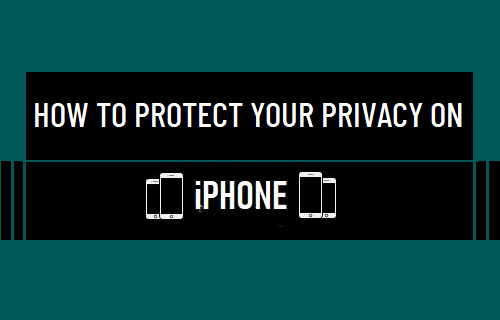
Protect Your Privacy on iPhone
As you may have noticed, Apps on iPhone request permission to access Contacts, Camera, Microphone, Photos and Location, either during installation or while they are being used.
This often results in users unknowingly providing unwanted Apps with the permission to access Microphone, Camera, Contacts, Location Data and other details.
Luckily, the General and Privacy Settings on iPhone can be easily tweaked to improve and protect your privacy in much better way.
1. Prevent Apps from Asking to Track your Activity
An easy way to rule out the possibility of accidentally or unknowingly allowing Apps to track your activity across other apps and websites is by preventing all Apps from asking to track your Activity on iPhone.
1. Go to Settings > Privacy & Security > Tracking.
2. On the next screen, move the toggle next to Allow Apps to Request to Track to OFF position.
![]()
Note: If the App is necessary, keep Allow Apps to Request to Track to ON position.
2. Prevent Apps from Tracking Your Location
The Location Tracking feature on iPhone is used by Apps like Maps, Weather, Find My iPhone and others to provide Directions, Weather Info and the Location of your Lost or Stolen iPhone.
However, there might be other unwanted Apps, tracking your Location Data and sharing this information with various third-party companies.
1. Go to Settings > Privacy & Security > Location Services.
2. On the next screen, select the App for which you want to disable location tracking.
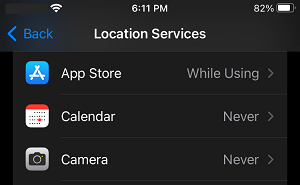
3. On the next screen, select the Never option to prevent the selected App from tracking your location.
![]()
Note: Select While Using the App, if you believe that a certain App has a valid reason to use your location data, while it is being used.
3. Prevent Websites from Tracking Your Location
The Safari browser on iPhone provides the option to prevent websites from tracking your location.
1. Go to Settings > Safari > Location.
2. On the next screen, select the Deny option.
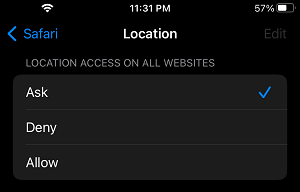
4. Periodically Clear Safari History and Website Data
A good way to protect your privacy on iPhone is to get into the habit of periodically clearing your Safari History and Website Data.
1. Open Settings > scroll down and tap on Safari.
2. On the next screen, tap on Clear History and Website Data link.
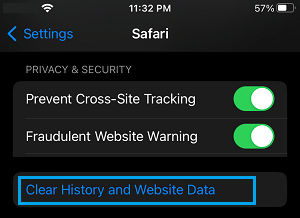
3. On the confirmation pop-up, tap on Clear History and Data to confirm.
This action will clear out all your browsing history, cookies and other website data from your device.
5. Prevent Unwanted Apps from Accessing Camera
While Apps like FaceTime, Skype and WhatsApp have a valid reason to access the Camera on your iPhone, you may have unknowingly allowed other unwanted apps with access to the Camera on your iPhone.
1. Go to Settings > Privacy & Security > Camera.
2. On the next screen, move the toggle next to unwanted Apps to OFF position.
This ensures that only the necessary or required Apps have access to Camera on your iPhone.
6. Prevent Apps from Accessing Microphone
Similarly, you may have unknowingly provided unwanted Apps with the permission to Access the Microphone on your iPhone.
1. Go to Settings > Privacy & Security > Microphone.
2. On the next screen, you can disable all unwanted Apps by moving the toggle to OFF position.
Note: If you need turn-by-turn audio directions, you need to provide Google Maps with access to Microphone.
7. Prevent Unwanted Apps from Accessing Photos
Make sure that only certain required apps are allowed to access your photos on iPhone.
1. Go to Settings > Privacy & Security > Photos.
2. On the next screen, disable unwanted Apps from accessing the Photos on your iPhone.
8. Prevent Apps from Accessing Contacts
Follow the steps below to prevent unwanted Apps from accessing your Contacts on iPhone.
1. Go to Settings > Privacy & Security > Contacts.
2. On the next screen, move the toggle next to Unwanted Apps to OFF position.
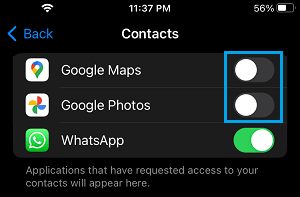
With these steps, you have disabled Facebook Messenger from accessing your Contacts on iPhone.
9. Disable Access to Notification Center from Lock Screen
While being able to access Notifications from Lock Screen is convenient, it can also allow someone else to take a look at your Message notifications.
1. Open Settings > scroll down and tap on Touch ID & Passcode.
2. On the next screen, scroll down to “Allow Access When Locked” section and move the toggle next to Notifications Center and Today View to OFF position.
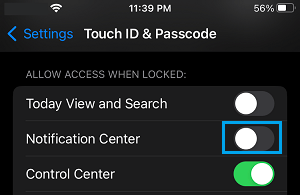
Once access to Notification Center and Today View is removed, no one will be able to View or Access Notifications on your iPhone, without knowing its Lock Screen Passcode.
10. Disable Message Previews on iPhone Lock Screen
Message Previews appearing on the Lock Screen of iPhone can also be read by others around you. Hence, it is better to disable Message Previews in Notifications on iPhone.
1. Go to Settings > Notifications > Messages > Show Previews.
2. On the next screen, make sure either When Unlocked or the Never option is selected.
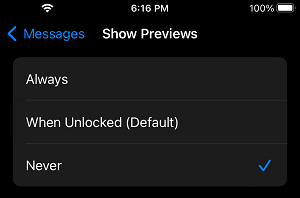
Note: The Never option totally removes Message Previews from both Lock Screen and Control Center Notifications.
Similarly, you may want to disable Content in Notifications from other messaging apps like WhatsApp, Signal and others.
11. Turn OFF Live Photos
The Live Photos feature on iPhone can end up recording your private conversations and the voice of people around you. Hence, you may want to disable this feature on your iPhone.
1. Open the Camera on iPhone > tap on Live Photo Icon and then tap on OFF.
![]()
2. You should now see the Live Photos Icon appearing with a strike mark.
![]()
12. Protect Voicemail Messages
Make sure that you lock the Voicemail on your iPhone with a strong Password.
1. Go to Settings > Phone > Change Voicemail Password.
2. On the next screen, type a strong Password to make sure that it cannot be guessed or broken.